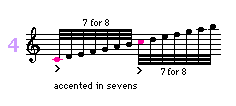Here an example of the C major scale played in quavers (eighth notes) over 2 octaves.
Audio 4.1

All red notes are firmly accented, but the notes in between are also played fully down to the bed of the keyboard.
Now listen carefully to Audio 4.2.
The metronome stays constant (at MM = 50) throughout the exercise, but the number of notes played from one beat to the next increases from 2 first to 3 and then to 4.
Once fluency is established, increase the speed of the scales by playing a complete octave (7 notes) in the same beat tempo that you set for the groups of two, three and four.
Play each scale over four octaves, and accent each tonic note. |
Audio 4.3
 |
Once you can do all above exercises effortlessly, take out all accents and play the scales evenly, but keep thinking the down beats in your mind. (Always start each practice session with playing a few scales in accented twos, threes, fours and octaves first.)
While playing scales always be conscious of the finger movement and realise that this is more a physical experience rather than a musical one.
Play each note firmly into the bed of the keyboard and raise the finger clear of the key immediately on striking the next note.
Apply this method to all scales.
In time good finger fluency will develop.
|